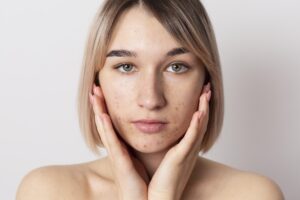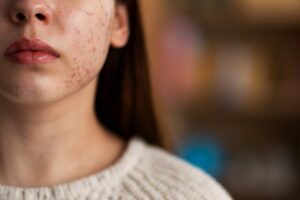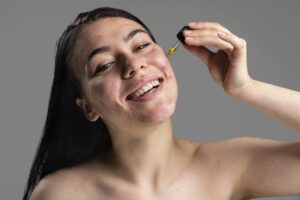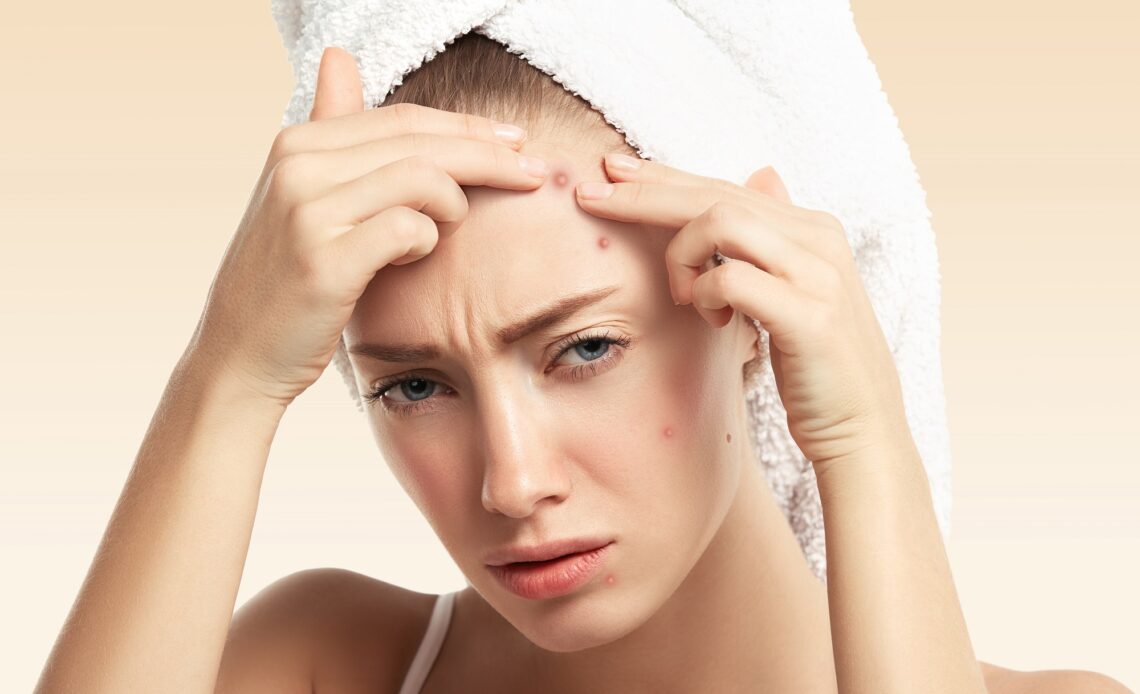What Is Acne?
Acne is a chronic skin condition that occurs when hair follicles become clogged with dead skin cells and oil. It is characterized by different types of blemishes on the face, back, chest and shoulders. Acne primarily affects teenagers and young adults, with about 85% of people between ages 12-24 experiencing minor acne. This is due to hormonal changes during puberty that stimulate oil production in the skin. However, acne can continue into adulthood and even affect babies.
There are several types of acne blemishes:
- Whiteheads – These are closed plugged pores. They appear as small, white, round bumps on the skin’s surface.
- Blackheads – These are open, plugged pores filled with dead skin cells and oil. The surface appears dark or black.
- Papules – Small, pink, tender bumps that are inflamed and painful.
- Pustules – Pus-filled pimples that have a white or yellow center surrounded by red inflammation.
- Nodules – Large, hard lumps below the skin’s surface that are painful and can cause scarring.
- Cysts – Deep, painful, pus-filled lesions that can cause scarring. These are a more severe form of pimples.
The primary causes of acne include excess oil production, clogged pores, bacteria, and inflammation. Hormonal changes during puberty increase androgen levels, which stimulates oil glands in the skin. Dead skin cells and oil build up in pores, creating a perfect environment for acne-causing bacteria to grow. This leads to inflammation, redness, and breakouts. Genetics and family history also play a role.

Causes of Acne
Acne occurs when hair follicles become plugged with oil and dead skin cells. There are four key factors that contribute to this:
- Excess oil production – The sebaceous glands in the skin produce an oily substance called sebum. This helps keep the skin moisturized. But when the body produces too much sebum, the excess can mix with dead skin cells and clog pores.
- Clogged pores – When pores get clogged with excess sebum and dead skin cells, it creates the perfect environment for pimples to form. The clogged material can form a whitehead if it stays below the surface of the skin. If it pushes through to the surface, it forms a blackhead.
- Bacteria – A type of bacteria that lives on the skin called Propionibacterium acnes, or P. acnes for short, can multiply inside a clogged pore. This leads to inflammation and the development of pimples and acne lesions.
- Hormones – Hormonal changes during puberty, menstruation, pregnancy, or menopause can increase sebum production. Androgens like testosterone cause the sebaceous glands to enlarge and make more sebum. This is why acne flare ups often occur around puberty.
Acne Triggers
Acne can flare up due to various triggers. Some of the most common acne triggers include:
- Puberty – The increase in androgens during puberty causes the sebaceous glands to enlarge and make more sebum. This excess oil clogs pores and allows bacteria to grow, resulting in acne.
- Stress – Stress increases the production of cortisol and other hormones that stimulate oil production. This can worsen acne. Stress also impairs the immune system, allowing bacteria to grow.
- Medications – Certain medications like lithium, barbiturates, androgenic steroids, and medications containing iodides or bromides can trigger acne.
- Cosmetics – Oil-based makeup, skin care products that clog pores, and harsh exfoliants can cause acne flare-ups. Look for non-comedogenic and oil-free cosmetics.
- Friction/Pressure – Sports helmets, backpacks, tight collars, and phone pressure on the face can worsen pimples by rubbing and putting pressure on the skin. Try to minimize friction and pressure on affected areas.
Acne Symptoms
It can manifest in various forms, each with their own distinguishing symptoms:

- Whiteheads – These appear as small, white, round bumps on the skin’s surface. They form when dead skin cells, oil, and bacteria become trapped within a pore.
- Blackheads – Also known as open comedones, these look like tiny dark dots on the skin. They develop when a pore becomes clogged with dead skin cells and oil, but remains open at the surface. The dark color occurs when the trapped debris is exposed to air.
- Papules – These are small, pink or red bumps that are tender to the touch. Papules occur when trapped dead skin cells, oil, and bacteria cause inflammation deep within the pores.
- Pustules – These pus-filled lesions form when a pore becomes severely inflamed. The tip of a pustule is white/yellow in color due to the accumulation of pus, comprised of oil, dead skin cells, and bacteria.
- Nodules – Large, hard lumps develop beneath the surface of the skin. They form when oil and bacteria make their way deep into the skin and cause inflammation in the tissues.
- Cysts – Painful, pus-filled lumps located deep in the skin. Cystic acne happens when a pore becomes blocked near a hair follicle, trapping oil and causing inflammation, which swells the area into a tender cyst.
Acne Treatment
There are several options for treating acne, from over-the-counter products to prescription medications and procedures done by a dermatologist.
Over-the-Counter Medications
Many acne treatments are available at drugstores without a prescription. These include:
- Benzoyl peroxide – Kills bacteria and reduces oil production. Found in creams, gels and cleansing bars. Can cause dryness and peeling.
- Salicylic acid – Helps unclog pores by exfoliating dead skin cells. Found in cleansers, moisturizers, pads, creams and masks. Can cause dryness.
- Sulfur – Helps remove excess oil and dead skin cells. Found in masks, creams and cleansing bars. Can be drying.
- Retinoids – Unclog pores and reduce oil production. Found in creams, gels and lotions. Can cause dryness and irritation. Examples include adapalene and tretinoin.
Prescription Medications
For more stubborn acne, a dermatologist may prescribe:
- Oral antibiotics – Kill bacteria and reduce inflammation. Examples are doxycycline and minocycline. Can cause side effects like upset stomach.
- Topical antibiotics – Applied directly to skin. Reduce bacteria and inflammation. Common options are clindamycin and erythromycin.
- Oral contraceptives – For women, certain birth control pills can help regulate hormones and reduce acne.
- Spironolactone – Oral medication that blocks androgen hormones to reduce oil production and inflammation.
- Isotretinoin – Powerful oral retinoid for severe, scarring acne. Requires close monitoring for side effects.
Light Therapy
Blue light therapy and photodynamic therapy involve using special wavelengths of light to kill acne bacteria. Requires multiple treatments by a dermatologist.
Extractions
Manual extraction of whiteheads, blackheads and cysts by a dermatologist using sterile tools. Provides immediate improvement.
Steroid Injections
Injecting a diluted corticosteroid directly into inflamed cysts to help reduce swelling and pain. Requires professional administration.
Prescription treatments should be used carefully under a dermatologist’s supervision. While effective, they can cause side effects. Over-the-counter options may be gentler for mild to moderate acne.
Home Remedies for Acne
There are several natural home remedies that can help treat acne and reduce the appearance of blemishes without harsh chemicals. Some of the most effective home remedies for acne include:
Tea Tree Oil

Tea tree oil is an essential oil that comes from the Melaleuca alternifolia plant, native to Australia. It has natural antibacterial and antimicrobial properties that make it effective at killing pimple-causing bacteria. Tea tree oil can help reduce inflammation and unplug blocked pores that lead to breakouts. Apply a small amount of diluted tea tree oil directly to blemishes at night using a cotton swab.
Aloe Vera
The aloe vera plant has soothing, healing properties that make it great for acne-prone skin. It contains salicylic acid, which helps unclog pores and reduce inflammation. The antibacterial properties of aloe vera gel also help kill bacteria on the skin’s surface. Apply pure aloe vera gel directly to clean skin in the morning and at night.
Honey
Honey has wound-healing and antimicrobial properties that make it helpful for treating acne. It can kill bacteria and reduce inflammation. Manuka honey, in particular, has been found to be effective against acne-causing bacteria. Dab a small amount of raw, organic honey directly onto breakouts or make a honey mask by mixing 2 teaspoons honey with 1 teaspoon of cinnamon.
Apple Cider Vinegar
Apple cider vinegar contains acids that help restore the skin’s natural pH levels. The acetic acid in apple cider vinegar has antibacterial effects that can kill pimple-causing bacteria. Mix 1 part apple cider vinegar with 3 parts water and apply it directly to pimples with a cotton ball, or make an apple cider vinegar toner.
Green Tea
Green tea is rich in antioxidants that reduce inflammation and help protect skin against damage. It also may help control excess sebum production. Drink 1-2 cups of brewed green tea per day and apply cooled green tea topically to help treat acne. Place cooled tea bags directly on active breakouts to reduce swelling.
Lifestyle Changes for Acne
Acne can be stubborn, but making some lifestyle adjustments may help clear up breakouts and prevent new ones. Here are some healthy habits to try:
Gentle Skin Care
- Use a mild, non-comedogenic cleanser twice a day. Avoid harsh scrubs or cleansing brushes which can irritate skin.
- After cleansing, apply a lightweight, oil-free moisturizer. This helps maintain the skin’s moisture barrier.
- When washing your face, use lukewarm water and avoid very hot water which can worsen acne.
- Change your pillowcase 1-2 times a week to avoid transferring oils and bacteria back to your skin.
Stress Management
- Stress does not necessarily cause acne, but it can aggravate breakouts.
- Try relaxing activities like yoga, meditation, or listening to music to lower stress levels.
- Getting enough sleep is key – aim for 7-9 hours per night. Lack of sleep increases cortisol which can trigger breakouts.
Healthy Diet
- Drink plenty of water to stay hydrated and support skin cell regeneration.
- Eat a balanced diet full of vegetables, fruits, whole grains, lean protein, nuts and seeds.
- Some studies link milk consumption and acne. If you think dairy is a trigger, try cutting back.
- Limit processed and refined carbs like white bread, chips, cookies etc.
Exercise
- Regular exercise supports circulation and delivers oxygen and nutrients to skin cells.
- Aim for 30-45 minutes most days of the week. Try cardio, strength training and flexibility exercises.
- Sweating during workouts followed by properly cleansing skin helps remove pore-clogging dirt and oil.
Making adjustments in skin care, stress, diet and exercise can all contribute to clearer skin from the inside out. While acne cannot always be prevented, healthy lifestyle choices can help reduce and manage breakouts for many people.
Makeup for Acne-Prone Skin
When you have acne-prone skin, it’s important to use non-comedogenic (non-pore clogging) makeup that won’t exacerbate breakouts. Here are some tips for choosing makeup if you are acne-prone:
- Use oil-free foundations, powders, and concealers. Oil-free formulas are less likely to clog pores and cause acne flare-ups. Look for products labelled non-comedogenic or oil-free on the packaging.
- Try mineral makeup. Mineral makeup contains finely milled mineral pigments, like zinc oxide and titanium dioxide, instead of oils and other pore-clogging ingredients. The minerals sit on top of the skin rather than sinking into pores.
- Use a green-tinted primer. Color correcting primers with a green hue help neutralize redness from pimples and even out skin tone. Apply before foundation for a smooth base.
- Avoid thick, creamy concealers. Lightweight liquid and powder concealers are better options for acne-prone skin. Heavy concealers are more likely to clog pores and feel uncomfortable on oily skin.
- Set makeup with a powder. Lightly dust a translucent powder over liquid makeup to help absorb oil and keep makeup looking fresher for longer.
- Remove makeup thoroughly each night. Never sleep in makeup! Use a gentle makeup remover and washcloth to remove all traces of makeup before bedtime.
With the right non-comedogenic makeup choices, you can create a flawless face without aggravating acne-prone skin. Focus on oil-free, mineral-based formulas for a clear complexion.
When to See a Dermatologist
While most cases of pimples can be treated with over-the-counter products, it’s important to recognize when to seek professional medical care. You should consider seeing a dermatologist if you have:
- Severe inflammatory pimples that causes nodules and cysts. Intense inflammatory acne often doesn’t respond to over-the-counter treatments and can lead to scarring. A dermatologist can prescribe stronger medications.
- Persistent cysts that don’t improve with other acne treatments. Cystic pimples can rupture and scar if not properly treated. A dermatologist can inject cysts with cortisone to help reduce inflammation.
- Acne that is leaving scars. Scarring is permanent damage to the skin. A dermatologist can perform treatments to minimize scarring and depigmentation from inflammatory acne lesions.
- Signs of a skin infection like warm, reddened skin, pus-filled pimples, fever, and body aches. Severe acne can progress to a bacterial infection that requires oral antibiotic treatment to resolve.
Seeing a dermatologist promptly for severe or persistent inflammatory acne can help minimize permanent skin damage from scarring. A dermatologist has access to prescription-strength acne treatments and procedures that can quickly get breakouts under control. Don’t hesitate to make an appointment if your acne is significantly impacting your physical or emotional wellbeing.
Acne Scars
Acne can leave behind scars, especially if the acne is severe. There are different types of acne scars:
- Ice pick scars – These are deep, narrow depressions in the skin that look like pits.
- Boxcar scars – These are round or oval depressions with steep edges.
- Rolling scars – These have a wavy texture and give the skin a bumpy appearance.
- Hyperpigmentation and post-inflammatory erythema – These aren’t actually scars but dark and red spots left behind from acne inflammation.
There are treatments that can help reduce the appearance of acne scars like laser resurfacing, dermabrasion, microneedling, and fillers. However, acne scars can be difficult to treat and results vary.
The best way to deal with acne scars is to try to prevent them in the first place. Don’t pick or pop pimples since that can make scarring worse. Treat acne and any inflammation early. Use sun protection which can help fade marks and scars over time. See a dermatologist if you have severe acne to reduce lasting scars.


